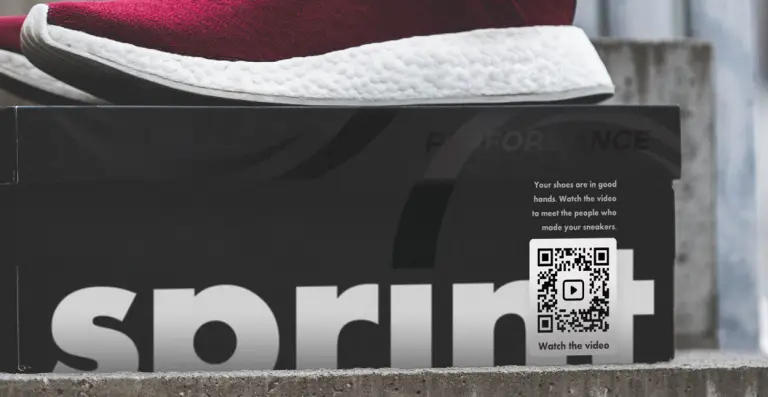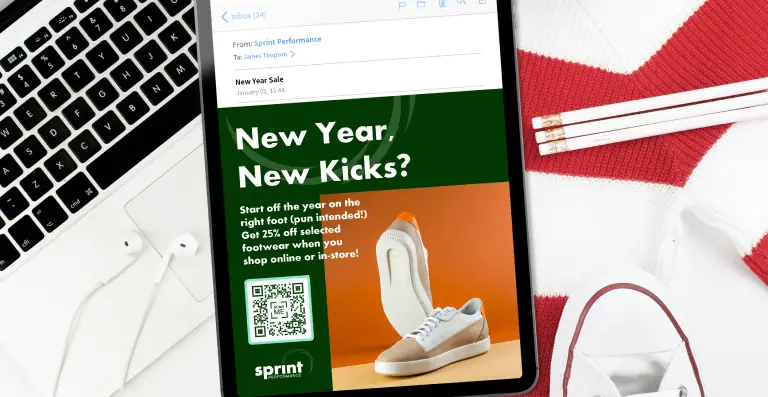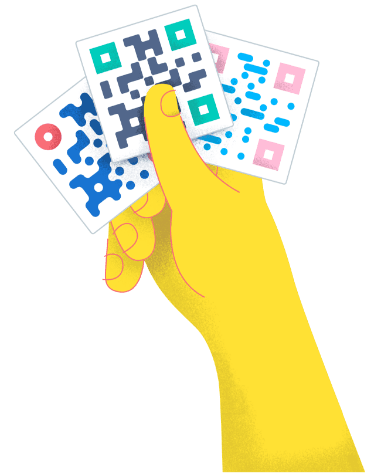- Best Practices ●
- COVID-19 ●
- Industry Trends ●
- Partners ●
- Product ●
Sneaker QR Code: 5 Pioneering Ways to Market Your Footwear Brand
A sneaker QR Code is a mobile-friendly tool to market footwear brands and increase conversion potential. Through various QR Code solutions, you can create seamless shopping experiences, which improve customer satisfaction and meet their expectations. Get ready to explore some nifty shop QR Code ideas that can elevate your sneaker brand.
-
Table of contents
- 5 sneaker QR Code use cases to amplify footwear marketing
- #1 Show brand transparency
- #2 Promote special offers
- #3 Leverage social media to boost online visits
- #4 Showcase more with print
- #5 Enhance retail therapy
- Best practices for QR Codes on footwear
- Aesthetics matter
- Make room for mistakes
- Analyze your marketing
- How to create QR Codes on shoes
- How to scan a sneaker QR Code
- Final words
5 sneaker QR Code use cases to amplify footwear marketing
With the continued advancement of technology in footwear coupled with the rise in smartphone usage, there’s never been a more fitting time to introduce innovative, smart, and convenient ways of marketing footwear products. Look no further than implementing QR Codes on shoes to bridge the gap between your offline content and online assets. These five chic QR Code types will take your brand to the next level.
#1 Show brand transparency
It’s not enough to be fashion-forward anymore. Planet-loving, socially conscious consumers demand supply chain transparency, standing up against fast fashion. Trendy retro footwear or not, Gen Z’s aren’t backing down. And why should they?
Consumers deserve to understand the supply chain practices behind the products they purchase. Being completely forthcoming about supply chain practices helps establish consumer trust, not to mention brand loyalty. If a consumer is well informed about their purchase—from where, by whom, and under what conditions it was made—they are more likely to buy from a particular brand.
Brands disclosing their practices publicly now have the opportunity to be pioneers in their industries, leading the movement toward a sustainability-first environment. Creativity makes a difference in how brands communicate their message. QR Codes can certainly make it easier to access this information while keeping its creativity up to par!
One way is to compile a video of your company’s practices and market it to your target audience by converting it to a Video QR Code that you place on your sneaker packaging. Alternatively, you can place a sneaker QR Code on your online shop which your consumers can scan to learn all about the product they’re about to buy.

#2 Promote special offers
Scarcity marketing is practically an ancient practice by now. And it’s no secret that it’s a standard marketing strategy. Look no further than consumers rushing to snag their bargain buys on occasions like Black Friday. But the idea isn’t to exploit customers with a false sense of urgency, rather it is to show them the highest value for money.
Being thoughtful when it comes to scarcity marketing practices is key, not unethical. This is why combining coupon marketing with scarcity marketing can be particularly helpful, leading to better bargains for customers and more conversions. That way it becomes mutually beneficial.
The bottom line: Consumers are looking for the most value for their buck, and they are not about to miss out on a terrific bargain if they may never get that deal again. This gives customers the opportunity to purchase products or services that they wouldn’t normally purchase. The fear of missing out (FOMO) gives them the incentive to take advantage of a good deal.
Setting this up for your footwear apparel brand couldn’t be simpler, either! Include a Coupon QR Code in your online store, email campaign, or even social media channels, edging customers closer to buying the next pair of kicks.

#3 Leverage social media to boost online visits
It is possible to increase your web traffic by using a few proven strategies. Paid ads, content marketing, and search engine optimization (SEO) are just a few ways to get an influx of online visitors. Getting traffic from social media is another proven method.
We all know by now that businesses can’t survive without an active online presence on social media sites like Facebook, LinkedIn, and Instagram. From increasing brand awareness to establishing meaningful connections with your followers, your business growth depends on your following.
With active social media engagement through regular posting and responding to comments and DMs, you can already get a sense of who your target audience is. This way you’ll have insider knowledge of what makes your audience tick. From that starting point, you can promote the products that they show an interest in.
One additional tool you can use to multiply traffic to your website is a customized QR Code. It is the same old business as usual—create content! But this time, drive traffic to your website by using a Dynamic URL QR Code.
As you may know already, sharing links over social media isn’t always easy as it may require an additional tool. But with a Dynamic URL QR Code solution, users can access links simply by scanning the Code, solving that problem right away.
Tip: Include a concise QR Code call to action (CTA) on your square so your followers know exactly what link they are being directed to.

#4 Showcase more with print
Unsure if printed catalogs are still in vogue? The simple answer is, yes! It may surprise you that traditional forms of print marketing are still the status quo, but it’s true: Catalog publishing has a future, and that future is digital. Well… kind of.
Today’s catalogs have implemented an omnichannel strategy, allowing their target audience to read and engage with print while also being able to visit online shops, leading to customer purchases.
So what you can expect is a printed catalog with a touch of digital, all thanks to the popularity of mobile phones and tablets. Merging these methods of advertising opens up a new realm of creativity and innovation, which could lead to more reader engagement and more conversion potential.
If you’re thinking about abandoning print altogether, consider a slight adaptation to print. You just need to adjust your approach. One way you can seamlessly integrate an omnichannel strategy is through QR Codes.
Whether you want to guide your target audience to your online shop, your app, or even your social media channel, you have a plethora of solutions at your fingertips. For example, if you want to drive traffic from your catalog to your store’s app, create an App QR Code. That way, when your audience scans a sneaker QR Code, they can open up a link on their mobile browser that will allow them to download the app. More browsing, more shopping!

#5 Enhance retail therapy
While many consumers certainly enjoy the convenience of online shopping, that doesn’t mean that the brick-and-mortar retail experience era is dead. Quite far from it actually. A majority of consumers in the US still prefer the traditional in-store shopping experience.
But one can’t deny the fluctuating nature of retail trends which inevitably impact consumer expectations. For example, retail trends show that consumers are pivoting towards shopping on social media, the metaverse, and more tailored shopping experiences, to name a few. The job of the retailer is to present the customer with options.
One way is to bring a digital element into your physical store, so the customer can have the best of both worlds. Digital signage is the perfect medium; it’s smart, interactive, and visual. In fact, 68% percent of customers admit that digital signage has influenced their purchasing decisions.
Displaying QR Codes on digital signage in your store is a perfect pairing. In doing so, you connect customers to any online content you direct them to. Want to grow your social media page for your footwear brand? Generate a Social Media QR Code so your customers can see more of your digital content on your active platforms, while they shop! Now that’s how you attract a tech-savvy generation, don’t you think?

Best practices for QR Codes on footwear
In order to ensure that you get the most from our QR Codes while making sure that you stay focused on your branding and marketing objectives, here are a few guidelines.
Aesthetics matter
When it comes to the look of your square, sticking to the stock standard black and white square, although a classic for sure, is overdone—the early nineties are a long time over. And there’s no shortage of customization features, too. Frames, patterns, colors, you name it. What’s more, is that you can bring elements of your brand assets to your sneaker QR Code by adding your footwear logo and colors. QR Code branding is especially effective for building brand awareness and recall.
Make room for mistakes
When creating your 2D square, you have a choice between Static QR Codes and Dynamic QR Codes. Static ones can be helpful for personal use, but leave no room for error. That’s because once you create the Static version, it can’t be undone, or edited. Dynamic versions can be edited at any time, which makes cleaning up mistakes a breeze. With this being said, make sure to test your QR Code on different devices.
Analyze your marketing
Another plus side of a Dynamic QR Code is that each scan becomes trackable and measurable. This makes it suitable for measuring your return on investment (ROI) on any of your marketing materials. QR Code tracking gives you an in-depth overview of user behavior, helping you analyze and see if your marketing efforts were worth the investment.
How to create QR Codes on shoes
- Sign up for an account on QR Code Generator.
- Select Create QR Code.
- Select the solution that makes sense for your footwear brand.
- Fill in the applicable details for your square.
- Customize it to fit your brand identity.
- Test, download, and get started!
How to scan a sneaker QR Code
- Open the camera app on your smartphone or tablet.
- Point the camera in the direction of the QR Code.
- Tap on the link that appears which will direct you to a landing page.
- Engage with the content and respond to the call to action.
For more information on how to scan a QR Code, check out our handy guide!
Final words
The fashion police have spoken: Using QR Codes on shoes is a footwear brand’s best-kept secret. Spread the news! While retail trends and consumer expectations continue to seesaw, one thing we know for sure is that frictionless omnichannel experiences are sticking around. And that certainly pans out well for our trusty old pixelated squares.




